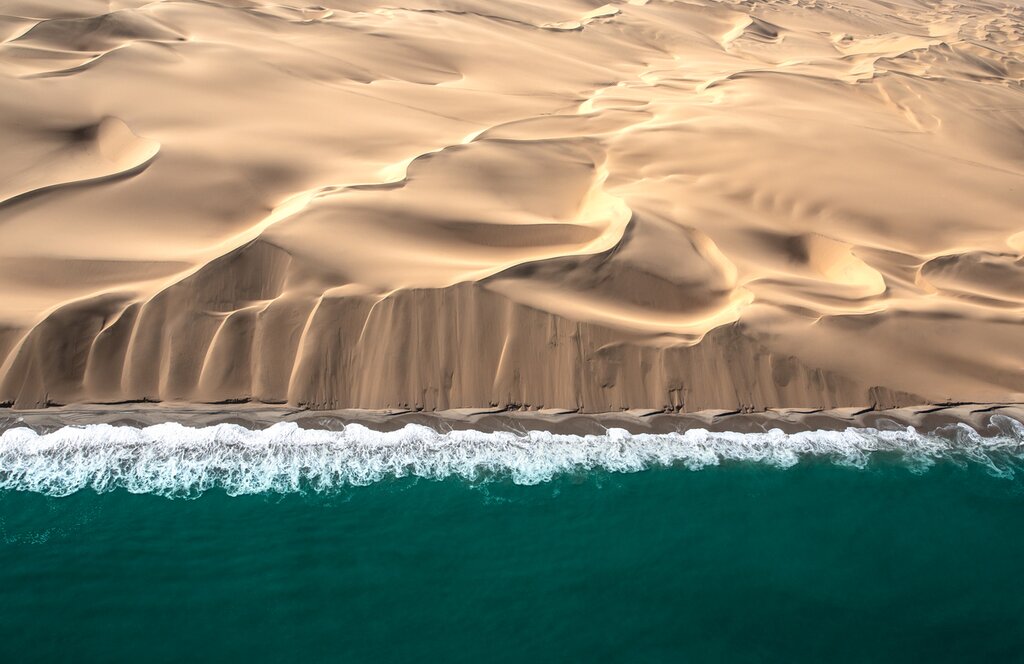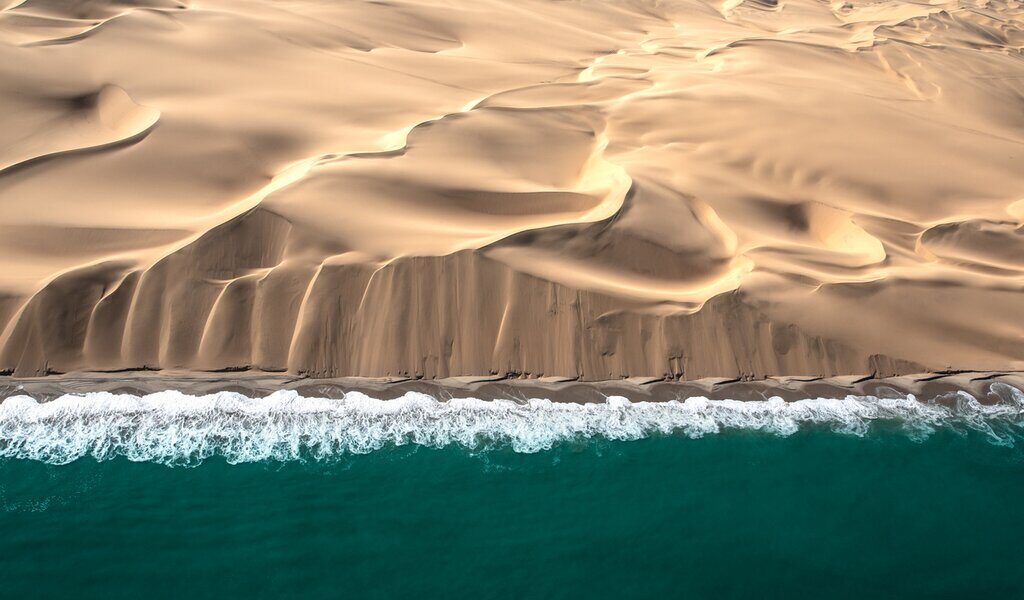
March is late summer in Namibia and is generally a hot time of year, although some areas are much hotter than others. Visit the capital, Windhoek, to enjoy cultural festivals; spot flamingoes at wetlands near Swakopmund; or take a 4WD safari along the Skeleton Coast. There’s plenty to see and do in Namibia, even in the low season. Read on to find out more.
Weather in Namibia During March
March in Namibia marks the tail end of summer, a season characterized by unique climatic conditions. As a nation situated in the Southern Hemisphere, Namibia experiences a reversed seasonal pattern compared to countries north of the equator. The weather in Namibia varies distinctly from south to north. Generally speaking, the southern regions tend to be hotter and drier, while the northern areas experience more rainfall and humidity. The central highlands, where the capital city, Windhoek, is located at a significant altitude (5,600 ft/1,700 m), enjoy a more temperate climate, offering a respite from the extremes found elsewhere. Expect pleasantly hot temperatures in Windhoek, typically around 90°F (32°C) during the day. However, the evenings and nights bring cooler air, providing a welcome contrast. In contrast, the desert regions experience much more intense heat. The vast expanse of the Kalahari, for example, can see temperatures soaring to a scorching 105°F (40°C) or even higher during the peak of the day. Along the coast, influenced by the cool Atlantic currents, conditions are considerably milder. The enigmatic Skeleton Coast and the mesmerizing dunes of Sossusvlei both experience average high temperatures in the mid-70s (Fahrenheit) during the Namibian summer, making them attractive destinations for those seeking to escape the inland heat. The variance in temperature across the country makes for diverse packing considerations.
Summer is also known as the wet season in Namibia, although the rainfall patterns are not uniform across the country. Days can often be hot and humid, with the possibility of intense, albeit brief, showers occurring in the late afternoons. These showers can sometimes be quite localized, meaning one area might experience a downpour while a nearby location remains dry. Heavy rains can pose challenges to accessibility in some parts of the country, particularly in regions with unpaved roads. Travelers should be aware of this potential for disruption and plan accordingly, perhaps by consulting with local guides or tour operators who have up-to-date information on road conditions. It is important to note that despite being the wet season, it typically does not rain incessantly every day. The mornings are often bright and clear, providing ample opportunities for outdoor activities and exploration. Visitors will find they can navigate the country without too much weather-related disruption.
Crowds and Costs in Namibia during March
March is considered part of the low season for tourism in Namibia. This is primarily due to the fact that many visitors are drawn to Namibia for its exceptional wildlife-viewing safaris, and the summer months are not generally regarded as the optimal time for game viewing. While Namibia remains a relatively “off-the-beaten-path” destination compared to some other more heavily touristed African safari locations, the summer season sees fewer dedicated safari enthusiasts. However, Namibia boasts a wealth of other attractions and activities that can be enjoyed regardless of the season. Therefore, travelers who choose to visit Namibia in March can take advantage of the reduced crowds and lower prices, experiencing the country’s unique landscapes and cultural attractions without the peak-season hustle and expense. Be sure to embrace the off-season and discover the uninhibited beauty of Namibia.
It’s worth noting that if Easter falls within the month of March, there may be a noticeable, albeit relatively small, increase in tourist activity. This is due to both international travelers taking advantage of the holiday period and local Namibian families using the long weekend for domestic travel. Popular destinations among locals during Easter include the capital city, Windhoek, as well as Okahandja, and Rehoboth, which offer various cultural and recreational activities. The coastal towns of Swakopmund, Walvis Bay, and Henties Bay are also favored destinations, offering a refreshing escape from the inland heat. If you are planning to travel to any of these locations during the Easter period, it is highly advisable to book your accommodation well in advance to avoid disappointment as the local tourism sector picks up.
Where to Go in Namibia during March
The Skeleton Coast, with its relatively mild summer temperatures, emerges as a particularly attractive destination during March. This dramatic and evocative stretch of coastline, located along the northwestern edge of Namibia, offers a unique and unforgettable experience. Skeleton Coast National Park, encompassing a significant portion of this coastline, is characterized by its vast, remote beaches, dramatic dunes, and the haunting remains of shipwrecks that have succumbed to the treacherous conditions over the years. These “skeletons” of ships provide a stark and captivating subject for photographers, lending an air of mystique and historical depth to the landscape. The southern regions of the park are more accessible, with guided 4WD tours offering an opportunity to explore the rugged terrain and witness the remarkable scenery. However, the northern reaches of the park are far more remote and can only be accessed by air, adding to their allure and exclusivity. Consider this unique area for the photography trip of a lifetime.
March is also an excellent month to explore the capital city, Windhoek. During this time, Windhoek comes alive with a vibrant cultural scene, hosting several lively festivals that add to its appeal. The Windhoek Karneval, a Germanic-inspired carnival, is a highlight, featuring a colorful street parade with elaborate floats and costumed participants, as well as a grand costumed ball. The Enjando Street Festival is another popular event, attracting performing groups from across Namibia who showcase their talents in music, dance, and traditional dress. Beyond the festivals, Windhoek offers a range of other attractions, including the serene National Botanic Garden of Namibia, showcasing the country’s diverse flora, and notable examples of Germanic architecture, such as the iconic Christuskirche, a beautiful Lutheran church that stands as a testament to Namibia’s colonial past. History buffs and nature enthusiasts are sure to enjoy the variety of Windhoek.
What to Do in Namibia in March
While the summer months might not be ideal for traditional game viewing safaris in Namibia, they offer excellent opportunities for bird-watching, particularly along the coast. The coastal city of Swakopmund is a prime location for observing large flocks of flamingos that gather in the wetlands near the city. The Walvis Bay Wetlands, located on the edge of the Namib Desert and just a short 30-minute drive from Swakopmund, are a particularly rewarding destination. Visitors can easily explore these wetlands independently or join a guided tour for a more in-depth experience. In addition to flamingos, the wetlands are home to pelicans and a wide variety of other bird species, making them a haven for ornithologists and nature enthusiasts. Enjoy the diverse bird populations of the region.
Travelers with an interest in traditional Namibian culture should consider visiting the Aawambo communities in northern Namibia around the time of the Oshituthi Shomagongo or Marula Fruit Festival, which typically takes place in late March and early April. This significant cultural event, recognized by UNESCO as an intangible cultural heritage tradition, centers around the marula fruit and the beverage made from it. During the festival, men traditionally carve utensils and serving tools, while women create baskets and pots and gather the marula fruit. People come together to sing traditional songs, recite poems, and share stories, celebrating their heritage and cultural identity. The festival is hosted by a different Aawambo community each year, and the best way to experience the full richness of the event is to join a guided tour that provides insights into the traditions and customs. The unique experience will create long-lasting memories.
Events Taking Place in Namibia during March
Independence Day, celebrated nationwide. This significant national holiday is observed on March 21st each year, commemorating Namibia’s independence from South African rule in 1990. The celebrations typically include banquets, parades, and other festive events held throughout the country.
Oshituthi Shomagongo, held in northern Namibia. This unique UNESCO Intangible Cultural Heritage festival takes place over three days in late March and early April, bringing together Aawambo (Ovambo) communities to prepare omagongo, a traditional drink made from the marula fruit. The event showcases the cultural heritage and traditions of the Aawambo people.
Windhoek Karneval, Windhoek. This Germanic-inspired carnival, held annually in the capital city during late March or early April, is a vibrant and colorful event featuring a street parade with elaborate floats and costumed participants, as well as a grand costumed ball.
Enjando Street Festival, in Windhoek. This lively two-day street festival showcases the music, dance, and colorful costumes of performing groups from across Namibia, attracting large crowds and creating a festive atmosphere in the capital.
Easter, celebrated nationwide. Easter, which can fall in either March or April, is a significant public holiday across Namibia, a predominantly Christian country (Lutheran and Catholic). The long Easter weekend is typically observed with closures of businesses and government offices, and many Namibians travel domestically to visit family and friends.
B-1698

